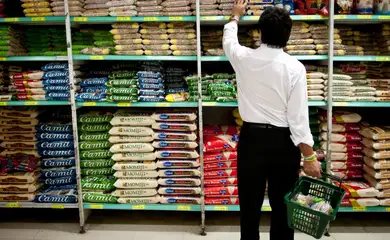Brazil: 30 years ago, Real Plan ended hyperinflation, balanced economy

One of the world economy's most innovative plans marks its 30th anniversary this Monday (Jul. 1). Exactly three decades ago, the cruzeiro real, a currency ravaged by hyperinflation, gave way to the real, stabilizing the Brazilian economy. This risky endeavor involved a form of social engineering to tackle inflation after multiple failed economic plans.

Amid numerous attempts to stabilize prices and wages through different indexers, the economic team of the Itamar Franco government introduced a groundbreaking approach: the Real Unit of Value (URV). Over three months, all prices and wages were denoted in both real cruzeiros and URVs, with its daily rate fluctuating and loosely tied to the dollar. This system persisted until the introduction of the real, when BRL 1 equaled 1 URV, and 1 URV equaled 2,750 cruzeiros reais.
“It was an extraordinarily risky and challenging process, filled with setbacks, and it could have gone wrong at any moment," recalled economist Persio Arida, one of the architects of the Real Plan, in an interview with TV Brasil during the book launch in São Paulo commemorating the plan's 30th anniversary.
Through indexing the entire economy, the URV effectively recalibrated what economists call relative prices, a measure used to gauge purchasing power across various goods and services. Coupled with an initially fixed exchange rate and high interest rates to attract foreign capital, the plan proved successful. By June 1994, the Broad National Consumer Price Index (IPCA) had surged to 47.43 percent. The indicator fell to 6.84 percent the following month and further dropped to just 1.71 percent by December 1994.
Political consensus
The success of the Real Plan, however, cannot be solely attributed to the URV. In a rare moment of political consensus and fatigue with hyperinflation, the National Congress played a crucial role in approving measures to restore public finances. Among these was the establishment of the Social Emergency Fund, which freed up a portion of government revenues and provided greater flexibility in budget execution during the latter half of 1993.
Virene Matesco, an economics professor at the Getulio Vargas Foundation (FGV)—a private higher education institution—emphasizes that political cooperation was crucial for the success of the Real Plan. "There was a political initiative by President Itamar Franco's transitional government. He set aside personal ambition and entrusted leadership to [then Finance Minister] Fernando Henrique Cardoso. This harmonious coordination between politics and the economy was instrumental in making a significant impact on society, especially amidst a disoriented Congress following the impeachment of former President Collor," she highlights.
Gustavo Franco, one of the creators of the Real Plan and former president of the Central Bank during the Fernando Henrique Cardoso administration, emphasizes that the Real Plan involved garnering political support before it was put into practice.
"The Real Plan was a public policy that involved individuals who understood the subject, communicated effectively, and were organized under political leadership to explain concepts and garner political support. Additionally, extensive social engineering was crucial to orchestrate such a significant collective endeavor, requiring engagement across the entire country. It was not a simple task," stated the economist at the launch of the plan's 30th anniversary book.
Benefits
Another architect of the Real Plan, economist Edmar Bacha, who served as president of the National Bank for Economic and Social Development (BNDES) at the start of the Fernando Henrique administration, emphasizes that the plan's primary goal was to decisively end hyperinflation. He notes that subsequent economic benefits, such as increased purchasing power, followed as a result.
"By putting an end to hyperinflation, the plan restored the purchasing power of workers' wages. No longer did wages erode, and workers no longer had to rush to the supermarket on payday to beat rising prices. The chaotic inflation that once defined Brazilian life has become a thing of the past. To gauge the plan's legacy, one need only look at Argentina today, which is currently attempting to achieve what we successfully accomplished 30 years ago," explains Bacha.
Recognition
Three decades later, economists from various backgrounds acknowledge the Real Plan's success in ending hyperinflation.
"The greatest achievement of the Real Plan was reducing inflation to civilized levels typical of any country with a stable economic system. Today, inflation hovers between 4 percent and 5 percent annually. The Real Plan's main accomplishment was fostering economic stability. In Brazil's previous economic state, the most affected were the poorest," remarks economist Leandro Horie from the Inter-Union Department of Statistics and Socio-Economic Studies (Dieese), while criticizing the impact of high interest rate policies on industry.
Economist Leda Paulani, also critical of high interest rates and the Brazilian economy's reliance on agribusiness, emphasizes that the elimination of price indexation was the primary benefit of the Real Plan. "It was highly successful in terms of achieving monetary stability and managed to give the Brazilian economy humanitarian stability. The Real Plan devised a unique solution for our specific type of inflation, which was characterized by indexation," she explains.
Virene Matesco expresses her emotional connection to lecturing about the Real Plan. "If our lives are significantly better today, it's thanks to our economists who crafted a plan that minimally disrupted the economy. In any society worldwide, combating inflation is exceedingly painful and disruptive. The Real Plan successfully ended hyperinflation with minimal discomfort. It was executed transparently, in well-defined stages, and effectively communicated to the population," she reflects.
*Vanessa Casalino from TV Brasil contributed to this report.





